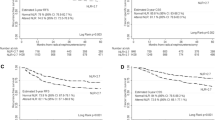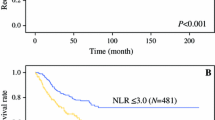Abstract
Background
The neutrophil-to-lymphocyte ratio (NLR) is a marker of systemic inflammation associated with recurrence and poor prognosis in numerous cancer types. The aim of this study was to evaluate the use of the NLR as a biomarker for intravesical recurrence (IVR) in patients undergoing radical nephroureterectomy (RNU) for upper urinary tract urothelial carcinoma (UTUC) for the first time.
Methods
We retrospectively analyzed the records of 100 patients with UTUC who had undergone RNU between 1999 and 2015 at our institution. The association between the preoperative NLR and IVR were assessed using multivariate models.
Results
Among the 100 patients enrolled in the study, 33 developed IVR during a median follow-up of 34 months. The receiver operating characteristic analysis revealed that the optimum cut-off value for the preoperative NLR was >3.8. A high preoperative NLR (n = 21) was associated with a significantly increased risk of lymph node involvement (p = 0.036) and IVR (p = 0.034) compared with a low preoperative NLR (n = 79). IVR-free survival in patients with a high preoperative NLR was significantly worse than that of patients with a low preoperative NLR (p = 0.018). On multivariate analysis, the preoperative NLR [hazard ratio (HR) 2.49; p = 0.015] and tumor multifocality (HR 2.96; p = 0.024) were independent risk factors predictive of IVR.
Conclusion
In our study population of patients with UTUC who had undergone RNU the preoperative NLR was associated with a significantly increased risk of IVR, suggesting that the NRL could be a useful biomarker for predicting IVR.

Similar content being viewed by others
References
Green DA, Rink M, Xylinas E et al (2013) Urothelial carcinoma of the bladder and the upper tract: disparate twins. J Urol 189:1214–1221
Rouprêt M, Babjuk M, Compérat E et al (2015) European association of urology guidelines on upper urinary tract urothelial cell carcinoma: 2015 update. Eur Urol 68:868–879
Sanderson KM, Cai J, Miranda G et al (2007) Upper tract urothelial recurrence following radical cystectomy for transitional cell carcinoma of the bladder: an analysis of 1,069 patients with 10-year followup. J Urol 177:2088–2094
Terakawa T, Miyake H, Muramaki M et al (2008) Risk factors for intravesical recurrence after surgical management of transitional cell carcinoma of the upper urinary tract. Urology 71:123–127
Novara G, De Marco V, Dalpiaz O et al (2008) Independent predictors of metachronous bladder transitional cell carcinoma (TCC) after nephroureterectomy for TCC of the upper urinary tract. BJU Int 101:1368–1374
Ku JH, Choi WS, Kwak C et al (2011) Bladder cancer after nephroureterectomy in patients with urothelial carcinoma of the upper urinary tract. Urol Oncol 29:383–387
Xylinas E, Kluth L, Passoni N et al (2014) Prediction of intravesical recurrence after radical nephroureterectomy: development of a clinical decision-making tool. Eur Urol 65:650–658
Liu Y, Lu J, Hong K et al (2014) Independent prognostic factors for initial intravesical recurrence after laparoscopic nephroureterectomy for upper urinary tract urothelial carcinoma. Urol Oncol 32:146–152
Seisen T, Granger B, Colin P et al (2015) A systematic review and meta-analysis of clinicopathologic factors linked to intravesical recurrence after radical nephroureterectomy to treat upper tract urothelial carcinoma. Eur Urol 67:1122–1133
Mantovani A, Allavena P, Sica A et al (2008) Cancer-related inflammation. Nature 454:436–444
Whiteside TL (2008) The tumor microenvironment and its role in promoting tumor growth. Oncogene 27:5904–5912
Yamanaka T, Matsumoto S, Teramukai S et al (2007) The baseline ratio of neutrophils to lymphocytes is associated with patient prognosis in advanced gastric cancer. Oncology 73:215–220
Walsh SR, Cook EJ, Goulder F et al (2005) Neutrophil-lymphocyte ratio as a prognostic factor in colorectal cancer. J Surg Oncol 91:181–184
Azab B, Bhatt VR, Phookan J et al (2012) Usefulness of the neutrophil-to-lymphocyte ratio in predicting short- and long-term mortality in breast cancer patients. Ann Surg Oncol 19:217–224
Ohno Y, Nakashima J, Ohori M et al (2010) Pretreatment neutrophil-to-lymphocyte ratio as an independent predictor of recurrence in patients with nonmetastatic renal cell carcinoma. J Urol 184:873–878
Kanda Y (2013) Investigation of the freely available easy-to-use software ‘EZR’ for medical statistics. Bone Marrow Transplant 48:452–458
Proctor MJ, Morrison DS, Talwar D et al (2011) A comparison of inflammation-based prognostic scores in patients with cancer. A Glasgow inflammation outcome study. Eur J Cancer 47:2633–2641
Azuma T, Matayoshi Y, Odani K et al (2013) Preoperative neutrophil-lymphocyte ratio as an independent prognostic marker for patients with upper urinary tract urothelial carcinoma. Clin Genitourin Cancer 11:337–341
Tanaka N, Kikuchi E, Kanao K et al (2014) A multi-institutional validation of the prognostic value of the neutrophil-to-lymphocyte ratio for upper tract urothelial carcinoma treated with radical nephroureterectomy. Ann Surg Oncol 21:4041–4048
Harris AL, Neal DE (1992) Bladder cancer—field versus clonal origin. N Engl J Med 326:759–761
Hinotsu S, Akaza H, Ohashi Y et al (1999) Intravesical chemotherapy for maximum prophylaxis of new early phase superficial bladder carcinoma treated by transurethral resection: a combined analysis of trials by the Japanese Urological Cancer Research Group using smoothed hazard function. Cancer 86:1818–1826
Catto JW, Hartmann A, Stoehr R et al (2006) Multifocal urothelial cancers with the mutator phenotype are of monoclonal origin and require panurothelial treatment for tumor clearance. J Urol 175:2323–2330
Takaoka E, Hinotsu S, Joraku A et al (2010) Pattern of intravesical recurrence after surgical treatment for urothelial cancer of the upper urinary tract: a single institutional retrospective long-term follow-up study. Int J Urol 17:623–628
Ito A, Shintaku I, Satoh M et al (2013) Intravesical seeding of upper urinary tract urothelial carcinoma cells during nephroureterectomy: an exploratory analysis from the THPMG trial. Jpn J Clin Oncol 43:1139–1144
Cho H, Hur HW, Kim SW et al (2009) Pre-treatment neutrophil to lymphocyte ratio is elevated in epithelial ovarian cancer and predicts survival after treatment. Cancer Immunol Immunother 58:15–23
De Larco JE, Wuertz BR, Furcht LT (2004) The potential role of neutrophils in promoting the metastatic phenotype of tumors releasing interleukin-8. Clin Cancer Res 10:4895–4900
Rodriguez PC, Ernstoff MS, Hernandez C et al (2009) Arginase I-producing myeloid-derived suppressor cells in renal cell carcinoma are a subpopulation of activated granulocytes. Cancer Res 69:1553–1560
Muller I, Munder M, Kropf P et al (2009) Polymorphonuclear neutrophils and T lymphocytes: strange bedfellows or brothers in arms? Trends Immunol 30:522–530
Hung HY, Chen JS, Yeh CY et al (2011) Effect of preoperative neutrophil-lymphocyte ratio on the surgical outcomes of stage II colon cancer patients who do not receive adjuvant chemotherapy. Int J Colorectal Dis 26:1059–1065
O’Brien T, Ray E, Singh R et al (2011) Prevention of bladder tumours after nephroureterectomy for primary upper urinary tract urothelial carcinoma: a prospective, multicentre, randomised clinical trial of a single postoperative intravesical dose of mitomycin C (the ODMIT-C Trial). Eur Urol 60:703–710
Author information
Authors and Affiliations
Corresponding author
Ethics declarations
Conflict of interest
The authors declare that they have no conflict of interest.
About this article
Cite this article
Kishimoto, N., Takao, T., Kuribayashi, S. et al. The neutrophil-to-lymphocyte ratio as a predictor of intravesical recurrence in patients with upper urinary tract urothelial carcinoma treated with radical nephroureterectomy. Int J Clin Oncol 22, 153–158 (2017). https://doi.org/10.1007/s10147-016-1040-7
Received:
Accepted:
Published:
Issue Date:
DOI: https://doi.org/10.1007/s10147-016-1040-7




